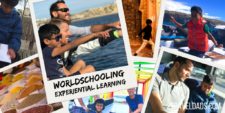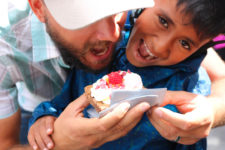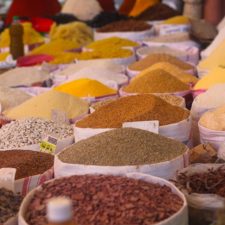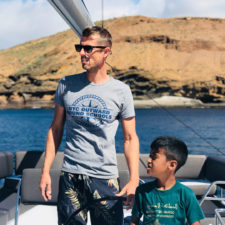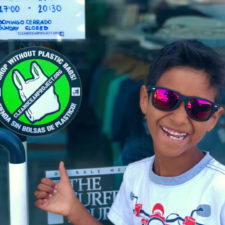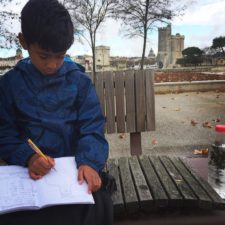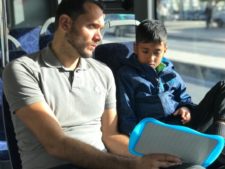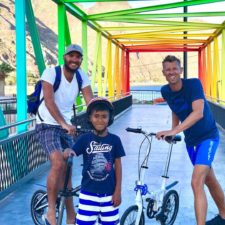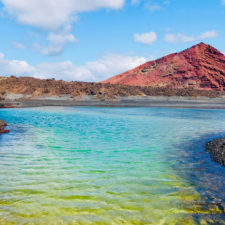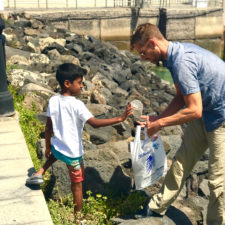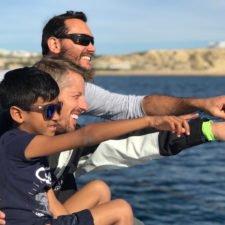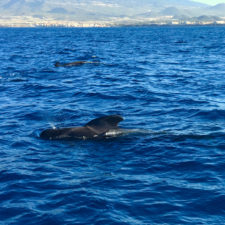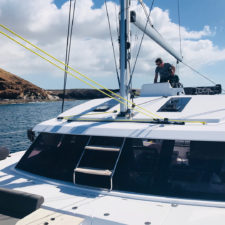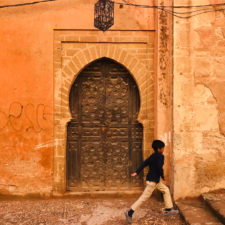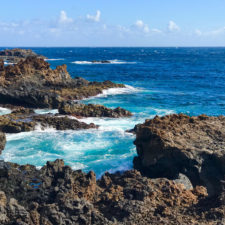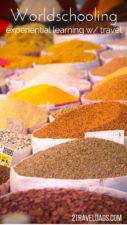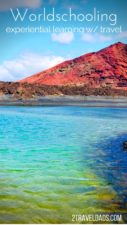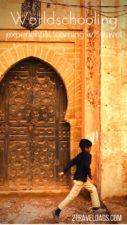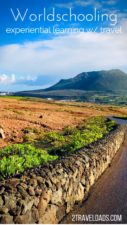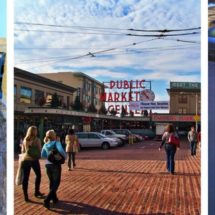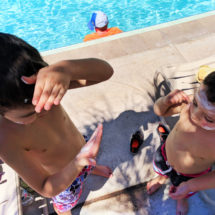Worldschooling can be a challenge but is clearly the right choice for our kids at this stage in our lives. And we’re not the only ones who feel this way. Some of our 2Dads friends, Court and Rafa of the Wind Expedition, are also worldschooling their son… but they’re doing it at sea and traveling all over Europe. They see this as an opportunity to educate Gabriel and give him the most educational and fulfilling experiences from early on via experiential learning.
Thank you so much, guys, for sharing your perspective and how you approach education and worldschooling at sea. It’s really incredible to hear and see your approach and the incredible benefits you’re providing your son. The world is the greatest classroom! …and now from Las Palmas, Canary Islands…
Worldschooling: basic skills in new places
We are continually asking our selves what methods of teaching or what daily experiences we can play up for our kids when we’re traveling so they can learn about more than the value of a good hike… or more than the importance of buying healthy groceries. Our 2TravelDads team all approach learning differently; worldschooing with Court and Raf is really cool, because with each port they come into, a new language, new currency, maybe even new units of measure make something as simple as daily math a moment of experiential learning.
Experiential learning for math and Spanish
“What is the value of quality food?” A question we ask ourselves and one we want our 7-year old to ponder. We shift into fieldwork (hands-on school work) in a bustling mercado central, Spanish farmers’ market, in Las Palmas, capital city of the island of Gran Canaria. It is here where the experiential learning begins.
It begins with Gabriel being given the choice between various fruterías (fruit sellers) and a string of questions to answer while exploring. “Would you like to visit the vendor with one employee, or six? more selection or less? thoughtful presentation of produce or a rugged feel? higher prices or lower?” Questions that we all think through daily as we navigate endless options; decisions which impact our food choice.
Gabriel chooses the vendor with more modern presentation and more employees. As we enter the frutería, he is handed a fieldwork journal, a set of questions to guide his exploration. He is expected to select at least five fruits and vegetables, record their names in Spanish, record their cost in Euros, predict the weight in kilograms, and make a prediction of whether produce is more or less expensive in grocery stores compared to the chosen market.
As he explores today’s ‘classroom’, time appears to change around him. The pace of the market seems to slow, the vendors behind the counter are intrigued by what they witness. Their smiles and care say it all. You see, they couldn’t ignore the learning that was taking place and felt compelled to participate in Gabe’s educational journey. As Gabe approached with his produce ready to be weighed, the man behind the counter greeted greeted him with a pleasant hola. A simple word never meant to such. Gabriel was in a safe learning environment filled with like-minded teachers with one unified goal, providing him with an impactful learning opportunity.
Gabriel handed the man behind the scale a bag of limones, and he called out, “I think the 4 lemons weigh 2 kilograms.” He had significantly overestimated its weight, which was to be expected since this was only his second time exploring weight of objects in the metric system. We then discussed the difference between grams and kilograms, helping us estimate the weight of ajos, garlic, our family’s favorite way to season just about everything. All the meanwhile, the friendly vendor waited patiently for Gabe to estimate the weight of each of the five he had selected.
After the manzanas (apples), guayaba (guavas), and fresas (strawberries) are weighed Gabriel places his coins on the counter for counting. As he is looking through the coins in front of him, the cashier lends a hand and helps him sift through his Euros. Gabe figures out the correct amount and with a smile plastered on his face. He let’s out a “gracias.” As we leave, I glance back at the fruteria and all looks as it did in the beginning, before the child, before the learning, before the experience. Except now, people seem to smile a bit more.
In this short period of time our 2nd grade son learned new words in Spanish, counting by 100s 10s 5s and 1s, estimating weight in kilograms and grams, adding decimals, counting change, and most importantly, the roles that others play in supporting his growth.
Easy worldschooling tools for any school age
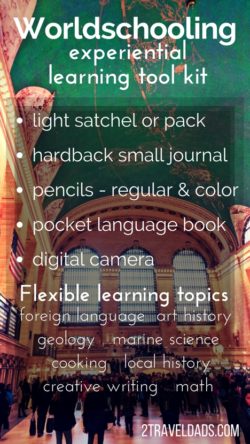 Just like Gabe learning about math and Spanish via a trip to the marketplace in Las Palmas, any travel can offer a variety of learning. To create your own “fieldwork journal” follow these steps before or once you’re traveling:
Just like Gabe learning about math and Spanish via a trip to the marketplace in Las Palmas, any travel can offer a variety of learning. To create your own “fieldwork journal” follow these steps before or once you’re traveling:
Start with a hardback journal book
Choose three topics to cover during worldschooling adventure
Allot one topic page per with two questions each
After topical questions, ask “What was most interesting about _____?”
Having a fieldwork journal like this makes worldschooling measurable and ensures that you can review what topics you’re working on following a particular trip or experience. Depending on your home municipality, there may be different requirements for reporting on education and demonstrating schooling practices, so journals are a great way to both reinforce learning and track progress.
A Road Map for a Worldschooling education plan
Opportunities, such as learning applied math in the marketplace, present themselves daily, whether you’re sailing to new destinations or venturing out from your own home base. It is a matter of welcoming them into your child’s educational plan to turn something simple into a learning experience. These are the opportunities you have dreamed of! You have made the decision to spend precious quality time with your child(ren), explore and experience the world around you. And if you haven’t made the decision for worldschooling, or even homeschooling yet, we’ll encourage you to get there.
As educators with over 20 years of combined experience in the public sector, we like to support other parents providing an education that they know, deep in their hearts, they can give their children. We want to support others who are excited by the unique opportunity to build a curriculum based on the interests of their child, their experiences, their community, and with the environment in mind.
Tip: other parents and educators are a great resource to tap into as you venture into worldschooling. Don’t be afraid to reach out or ask for help as you set our on an education journey like this. Experiential learning is both an amazing and a bumpy road at times.
Where do you begin: how to start worldschooling
Most of us went to a school with a structured curriculum, complete with readings, ‘xeroxed’ worksheets, textbooks, and assessments. Good news: we all made it just fine. However, we also spent many hours in school thinking about how our time could be better spent. The world away from a child-sized desk, bound books, and a stack of papers is much more colorful and interesting. A new wave of teachers across the country would give anything for an opportunity to leave the walls of a classroom most days of the week in order to explore the world with their students. As parents (you and us) actively worldschooling our kids, we all can take advantage of it.
Creating interest-based experiences and daily lesson plans may seem as daunting and frustrating as driving before GPS, but country roads and cozy towns are more easily uncovered and can be a more memorable experience than the ubiquitous concrete interstate. The rewards are tangible and the experiences lasting.
Note: interest-based learning doesn’t mean that kids get to pick and choose what they learn, but it means that education is being tailored to the stronger interests with elements of the less-fascinating topics working their way in to ensure a well rounded learning plan.
Example: a child who loves learning about animals but despises penmanship can benefit from practicing writing about animals. A child that struggles with reading comprehension may thrive with cooking, so teaching how to read and follow recipes can bridge the learning gap.
Designing an individual child based curricula in conjunction with the required state curriculum is what every great teacher dreams of. You will be teaching skills and applying them immediately in a meaningful real world application. That’s what experiential learning is. Additionally, knowing the needs of your own child will be much easier than an entire class. Reflective and motivated educators struggle daily to teach in the moment, to teach to each child’s interests and to have real impact on the individual learner’s life. Experiential learning in worldschooling is where the student naturally gains and, in turn, shares the knowledge they have acquire. It’s where authentic learning lives and authentic assessment thrives.
Note: just like how experiential learning will vary from child to child, so will how they show their knowledge. This is both the struggle and the beauty of getting to worldschool. While some states may require standardized tests at certain stages of education, as a parent/educator you’ll be able to develop ways that truly highlight strengths and opportunities of your child as you homeschool and build off of experiential learning.
One unique aspect of world schooling is that learning can be based on current challenges your child faces, the environment, the community, the political climate, and your family’s needs. Real time needs-based learning is very engaging to the learner and the educator. There is deep learning entrenched in challenges that arise. Teaching your own kid(s) provides a mistake sanctuary. In teaching and experiencing rich world learning, you shift yourself seamlessly back and forth from learner to instructor. You model how you learn, show them your vulnerability as you make mistakes, and teach them how to learn from their own.
We’ve come to see that open discussion about life helps our son to both learn from our daily experiences as well as feel like he’s just as important as we are. A side lesson to experiential learning with school subjects, need-based learning teaches kids emotional health and logic as well. Isn’t it incredible to be able to offer such personal education and home-grown set of life skills?
First steps to experiential learning through worldschooling
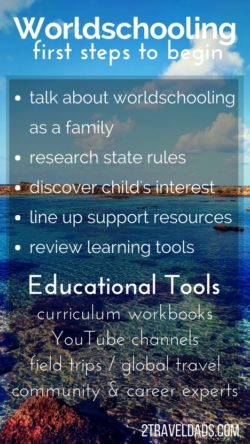 Commit to planning authentic experiences! Break out of the workbook and break into the world that surrounds you! Research what learning is required in your state. Ask your child what they are most interested in or most want to learn. Reach out to friends, scientists and other professionals in your community and collaborate with them. Most would love to share what they do and interact with your child.
Commit to planning authentic experiences! Break out of the workbook and break into the world that surrounds you! Research what learning is required in your state. Ask your child what they are most interested in or most want to learn. Reach out to friends, scientists and other professionals in your community and collaborate with them. Most would love to share what they do and interact with your child.
Make lasting positive impacts on the people and places around you. Take the time that teachers so genuinely wish they had to reach your child where they stand.
In the articles to come, it is our intention to provide you with ways to introduce education content in a more meaningful and lasting way while ensuring your child is meeting required state standards. We will share our experiences and pitfalls along this educational journey around the world. We welcome you to take the journey with us!
If you have questions, comments or ideas, please reach out to the 2TravelDads team to share. We are all here, whether on land in Seattle or at sea in the Mediterranean, and we’re all about being a part of a supportive community of parents around the globe, teaching our kids all they need through experiential learning and growing them into incredible individuals as they grow.
Care to pin this for your starting your own journey of worldschooling and experiential learning within your own family? Go for it!

